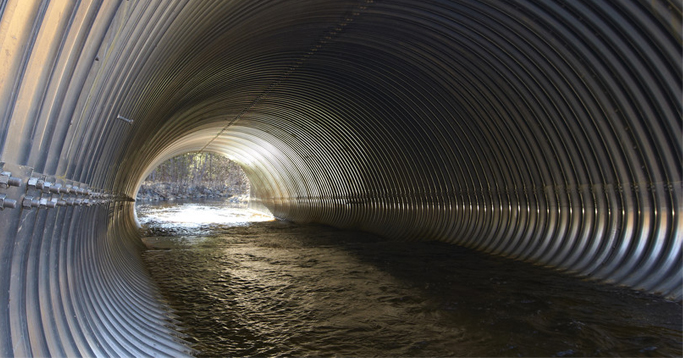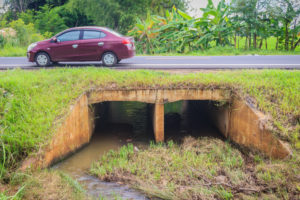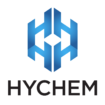Geopolymer: the culvert operative

Culverts, like other water infrastructure, is aging and deteriorating at an increasing rate in Australia, and asset owners face the task of needing to rehabilitate or rebuild these assets before they become a serious danger to the public. While rebuilding culverts is a costly, time consuming and potentially disruptive task, geopolymer provides a solution for rehabilitation that is quick, cost effective and can return structural integrity.
A culvert is a tunnel structure that runs under a road, railway or portion of land to provide cross drainage. They can be made from concrete or corrugated metal pipe (CMP), with both materials susceptible to the effects of abrasion damage that is common in hydraulic structures. This damage is caused by the abrasive effects of waterborne silt, sand, gravel, rocks, ice, and other debris impinging on the material’s surface.
The most common structural damage found in CMP culverts is the erosion of the protective galvanised coating, leaving the steel pipe exposed which over time rusts away. On the other hand, concrete culverts suffer from abrasion erosion which is readily recognised by its smooth, worn appearance. In both situations, the structural integrity of the culvert is compromised, and action needs to be taken to prevent failure.
A reliable alternative

When culverts are deteriorating and failing, there are two options for asset owners: rebuild or rehabilitate.
Rebuilding is costly, time consuming and potentially disruptive to the public. Rehabilitation is an ideal option to mitigate these factors and extend the life of a culvert while preventing further damage from occurring.
While often times an epoxy liner or calcium aluminate cement (CAC) are more widely considered in Australia for culvert rehabilitation, the benefits of geopolymer can’t be ignored. Epoxy liner effectively protects the structure from abrasion and corrosion, however it’s properties don’t provide the same level of structural integrity as Geopolymer.
Product Manager for Hychem, Colin Murphy, said geopolymer is a preferred alternative solution to epoxy shotcrete or CAC as it has the benefit of increasing structural integrity, superior strength and chemical resistance, and is quick and easy to install.
“Geopolymer will give you the peace of mind that you are getting a long term, durable solution in the face of a failing culvert,” Mr Murphy said.
Hychem manufactures under licence the GeoCast Reliner with MSP which is ideal for rehabilitating aging infrastructure and eliminating costly replacement.
It is suitable for the structural rehabilitation of large diameter pipes consisting of metal, concrete, stone, masonry and more. It can also be used on corrugated metal pipe and concrete culverts to re-establish structural integrity and protect against erosion.
“Our high performance Geocast Reliner with MSP is a fibre reinforced, corrosion resistant mortar that is applied by centrifugally casting or using an air atomising shotcrete nozzle, which makes quick work of any project,” Mr Murphy said.
“The centrifugal application allows ease of application and can be used around large curves. It’s designed for quick turnaround with an initial curing time of 4.5 hours, and the asset can return to service within 18 hours. Accelerators can also be used to speed up this process.”
Geocast Reliner with MSP can be applied to 100mm thickness overhead and stops water infiltration. Unlike regular cement, it does not corrode or attack the reinforcing steel in concrete converts. It can also be applied thinner than shotcrete therefore minimising the loss of internal diameter.
“Deteriorating culverts have the potential to do a lot of damage. Geopolymers provide a smart, cost effective solution that reinstates culvert structural integrity, protects against erosion and extend its life, postponing replacement,” Mr Murphy said.
